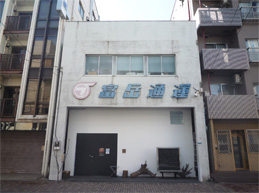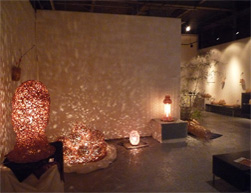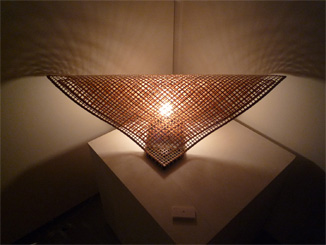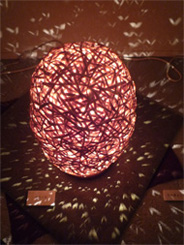 |
|
 |
| The unassuming facade of Coexist Gallery on an Akihabara back street. |
|
Shadow patterns provide a twinkling backdrop for Hosaka's 3D pieces. |
|
Coexist Gallery recently moved to an Akihabara side street from its former location in Roppongi. Now occupying an old factory building, Coexist refers to itself as an eco-art gallery; its motto is "Think the Earth through Art." When I visited recently, it was quiet and dark save for the warm glow emitting from Norio Hosaka's striking bamboo sculptures.
Born in 1940 in Yamanashi Prefecture, Hosaka studied industrial and craft design at Musashino Art University. He worked as a product designer for fifteen years before establishing his own sculpture studio, first in Kofu and then later in Yatsugatake, where his pieces grew in scale. From a young age he was intrigued by the unique qualities of bamboo. Known for being lightweight, strong and flexible, bamboo is, as Hosaka puts it, "a plastic material given to us by nature."
It is hard to overstate the potential of bamboo. It has been used for centuries throughout Asia to create objects of daily life such as basketry, dishes, furnishings and building materials. For a little over a century bamboo-ware as an art form has evolved from the anonymity of craftsmen to the status of recognizable work by individual artists. Hayakawa Shokosai (1815-97) is thought to be the first bamboo artist to inscribe his name on his pieces. The art form's short history was more recently propelled by Iizuka Rokansai (1899-1957), one of the first Japanese bamboo artists to receive international acclaim, followed by Shono Shounsai (1904-74), who in 1967 was named Japan's first Living National Treasure in bamboo arts.
Norio Hosaka's work pushes the boundaries of his chosen medium even further beyond its classic use in Asian handicrafts. In Habataku (Taking Off) the weave pattern appears to be traditional. The upturned tail wing shape of the piece, however, is reminiscent of sixties architecture, which Hosaka may have been influenced by in his earlier years as an industrial designer.
Some of his pieces employ a more traditional basket-weave technique, whereas others appear to use a random weave, a scramble. Like any kind of scramble, there are still some rules that must be followed so it doesn't descend into chaos. In Twin Link, a random scramble weave gives way to an orderly traditional pattern. Hosaka has grafted his own original technique onto that of his tradition. The vase-like shape is symmetrical but does not conjure an image that is strictly Japanese or Western. I had to laugh when I realized that the title of another piece, Kibou no Tamago, means Egg of Hope, as it also employs what I refer to as the scramble weave pattern. What appears to be random is, however, markedly disciplined in its execution. The artist's comment beside the piece reads, "Light emitting from this piece creates the shape of butterflies."
Omoi (Thought) is a figurative piece that resembles a face with a red stripe down the nose. Between Omoi and a stunning shadow cast on the wall by a hanging pendant is a lovely but unlit vase that is literally overshadowed by these two other pieces. The darkness of the exhibit space allows visitors to appreciate Hosaka's light sculptures. The 3D pieces that do not emit light, however, appear flat and obscure next to their glowing cousins. In future retrospective shows, his lit and unlit works should be displayed separately so as to provide appropriate lighting conditions for each type.
Hosaka continues to produce striking pieces out of bamboo that transcend existing notions of the medium. He is a part-time professor at Aichi Prefectural University of Fine Arts and Music and Musashino Art University, and often gives guest lectures at arts and crafts schools including his alma mater. In his book Hosaka Norio Bamboo Art: Phantasmagoric Bamboo (1999) he states, "I think it is one of my important roles to transmit my experience and philosophy to the next generation."
 |
|
 |
| Habataku (Taking Off) demonstrates Hosaka's mastery of traditional bamboo basket weaving techniques. |
|
Kibou no Tamago (Egg of Hope) emits butterfly-shaped light. |
|
|